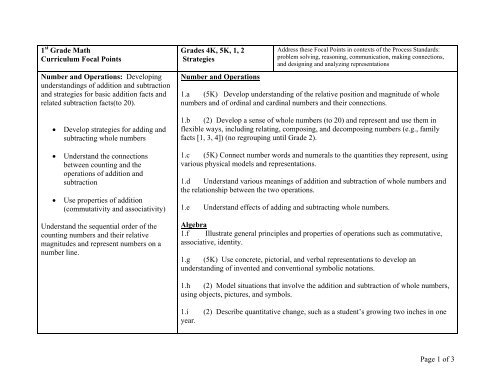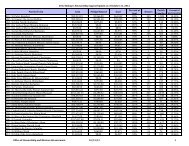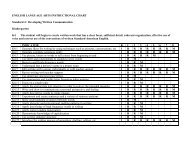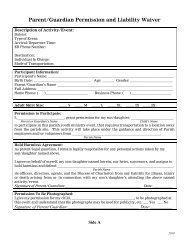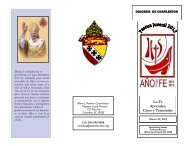Page 1 of 3 1 Grade Math Curriculum Focal Points Grades 4K, 5K, 1 ...
Page 1 of 3 1 Grade Math Curriculum Focal Points Grades 4K, 5K, 1 ...
Page 1 of 3 1 Grade Math Curriculum Focal Points Grades 4K, 5K, 1 ...
You also want an ePaper? Increase the reach of your titles
YUMPU automatically turns print PDFs into web optimized ePapers that Google loves.
1 st <strong>Grade</strong> <strong>Math</strong><br />
<strong>Curriculum</strong> <strong>Focal</strong> <strong>Points</strong><br />
Number and Operations: Developing<br />
understandings <strong>of</strong> addition and subtraction<br />
and strategies for basic addition facts and<br />
related subtraction facts(to 20).<br />
• Develop strategies for adding and<br />
subtracting whole numbers<br />
• Understand the connections<br />
between counting and the<br />
operations <strong>of</strong> addition and<br />
subtraction<br />
• Use properties <strong>of</strong> addition<br />
(commutativity and associativity)<br />
Understand the sequential order <strong>of</strong> the<br />
counting numbers and their relative<br />
magnitudes and represent numbers on a<br />
number line.<br />
<strong>Grade</strong>s <strong>4K</strong>, <strong>5K</strong>, 1, 2<br />
Strategies<br />
Number and Operations<br />
Address these <strong>Focal</strong> <strong>Points</strong> in contexts <strong>of</strong> the Process Standards:<br />
problem solving, reasoning, communication, making connections,<br />
and designing and analyzing representations<br />
1.a (<strong>5K</strong>) Develop understanding <strong>of</strong> the relative position and magnitude <strong>of</strong> whole<br />
numbers and <strong>of</strong> ordinal and cardinal numbers and their connections.<br />
1.b (2) Develop a sense <strong>of</strong> whole numbers (to 20) and represent and use them in<br />
flexible ways, including relating, composing, and decomposing numbers (e.g., family<br />
facts [1, 3, 4]) (no regrouping until <strong>Grade</strong> 2).<br />
1.c (<strong>5K</strong>) Connect number words and numerals to the quantities they represent, using<br />
various physical models and representations.<br />
1.d Understand various meanings <strong>of</strong> addition and subtraction <strong>of</strong> whole numbers and<br />
the relationship between the two operations.<br />
1.e Understand effects <strong>of</strong> adding and subtracting whole numbers.<br />
Algebra<br />
1.f Illustrate general principles and properties <strong>of</strong> operations such as commutative,<br />
associative, identity.<br />
1.g (<strong>5K</strong>) Use concrete, pictorial, and verbal representations to develop an<br />
understanding <strong>of</strong> invented and conventional symbolic notations.<br />
1.h (2) Model situations that involve the addition and subtraction <strong>of</strong> whole numbers,<br />
using objects, pictures, and symbols.<br />
1.i (2) Describe quantitative change, such as a student’s growing two inches in one<br />
year.<br />
<strong>Page</strong> 1 <strong>of</strong> 3
1 st <strong>Grade</strong> <strong>Math</strong><br />
<strong>Curriculum</strong> <strong>Focal</strong> <strong>Points</strong><br />
Number and Operations and Algebra:<br />
Developing an understanding <strong>of</strong> whole<br />
number relationships, including grouping<br />
in tens and ones.<br />
• Compare and order whole numbers<br />
(at least to 100)<br />
• Compare and order whole numbers<br />
(10-100) in terms <strong>of</strong> groups <strong>of</strong> tens<br />
and ones.<br />
Geometry: Composing and decomposing<br />
geometric shapes.<br />
• Compose and decompose plane and<br />
solid figures (2 isosceles triangles =<br />
rhombus, etc.)<br />
• Initial understanding <strong>of</strong> such<br />
properties as congruence and<br />
symmetry.<br />
<strong>Grade</strong>s <strong>4K</strong>, <strong>5K</strong>, 1, 2<br />
Strategies<br />
Geometry<br />
Address these <strong>Focal</strong> <strong>Points</strong> in contexts <strong>of</strong> the Process Standards:<br />
problem solving, reasoning, communication, making connections,<br />
and designing and analyzing representations<br />
1.j (<strong>4K</strong>, <strong>5K</strong>) Recognize, build, draw, compare and sort two- and three-dimensional<br />
shapes and name two-dimensional shapes.<br />
1.k (<strong>4K</strong>) Describe attributes and parts <strong>of</strong> two- and three-dimensional shapes.<br />
1.l Investigate and predict the results <strong>of</strong> putting together and taking apart two- and<br />
three-dimensional shapes.<br />
1.m Recognize and create shapes that have symmetry.<br />
1.n (<strong>4K</strong>, <strong>5K</strong>) Create mental images <strong>of</strong> geometric shapes using spatial memory and<br />
spatial visualization.<br />
1.o Recognize and represent shapes from different perspectives.<br />
1.p (<strong>5K</strong>) Recognize geometric shapes and structures in the environment and specify<br />
their location.<br />
Measurement<br />
1.q (<strong>4K</strong>, <strong>5K</strong>) Recognize the attributes <strong>of</strong> length, volume, weight, area, and time.<br />
• Describe geometric attributes and<br />
properties.<br />
<strong>Page</strong> 2 <strong>of</strong> 3
1 st <strong>Grade</strong> <strong>Math</strong><br />
<strong>Curriculum</strong> <strong>Focal</strong> <strong>Points</strong><br />
<strong>Grade</strong>s <strong>4K</strong>, <strong>5K</strong>, 1, 2<br />
Strategies<br />
Data Analysis and Probability<br />
Address these <strong>Focal</strong> <strong>Points</strong> in contexts <strong>of</strong> the Process Standards:<br />
problem solving, reasoning, communication, making<br />
connections, and designing and analyzing representations<br />
1.r (<strong>4K</strong>, <strong>5K</strong>) Sort and classify objects according to their attributes and organize data<br />
about the objects.<br />
1.s Represent data using concrete objects, pictures, and graphs.<br />
1.t (<strong>5K</strong>) Describe parts <strong>of</strong> the data and the set <strong>of</strong> data as a whole to determine what<br />
the data show.<br />
Critical Concepts That Are Not <strong>Focal</strong> <strong>Points</strong><br />
Money<br />
1.u Sort, classify, and name coins and denote their values.<br />
Time<br />
1.v Understand measure <strong>of</strong> time to include months <strong>of</strong> the year, days <strong>of</strong> the week, and<br />
hours <strong>of</strong> the day.<br />
1.w Tell time to nearest hour using analog and digital clocks.<br />
<strong>Page</strong> 3 <strong>of</strong> 3


